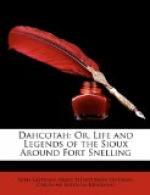The Sacred Feast is given in honor of the sacred medicine, and is always given by medicine-men or women who are initiated into the mysteries of the medicine dance. The medicine men are invariably the greatest rascals of the band, yet the utmost respect is shown them. Every one fears the power of a medicine man. When a medicine man intends giving a feast, he goes or sends to the persons whom he wishes to invite. When all are assembled, the giver of the feast opens the medicine bag with some formality. The pipe is lit and smoked by all present; but it is first offered to the Great Spirit. After the smoking, food is placed in wooden bowls, or other vessels that visitors may have brought; for it is not a breach of etiquette to bring dishes with you to the feast. When all are served, the word is given to commence eating, and those that cannot eat all that is given them, must make a present to the host, besides hiring some one present to eat what they fail to consume. To waste a morsel would offend the Great Spirit, and injure or render useless the medicine. Every one having finished eating, the kettle in which the food was cooked is smoked with cedar leaves or grass. Before the cooking is commenced, all the fire within the wigwam is put out, and a fresh one made from flint and steel. In the celebration of the Sacred Feast, the fire and cooking utensils are kept and consecrated exclusively to that purpose. After the feast is over, all the bones are carefully collected and thrown into the water, in order that no dog may get them, nor a woman trample on them.
The Sioux worship the sun. The sun dance is performed by young warriors who dance, at intervals of five minutes, for several days. They hop on one foot and then on the other, keeping time to the drum, and making indescribable gestures, each having a small whistle in his mouth, with his face turned towards the sun. The singing and other music is performed by the medicine men. The drum used is a raw hide stretched over a keg, on which a regular beating of time is made with a short stick with a head to it. Women pretend to foretell future events, and, for this reason, are sometimes invited to medicine feasts.
II.
INDIAN DOCTORS.
When an Indian is sick and wants “the Doctor” as we say, or a medicine man, as they say,—they call them also priests, doctors and jugglers,—a messenger is sent for one, with a pipe filled in one hand, and payment in the other; which fee may be a gun, blanket, kettle or anything in the way of present. The messenger enters the wigwam (or teepee, as the houses of the Sioux are called) of the juggler, presents the pipe, and lays the present or fee beside him. Having smoked, the Doctor goes to the teepee of the patient, takes a seat at some distance from him, divests himself of coat or blanket, and pulls his leggins to his ankles. He then calls for a gourd, which




